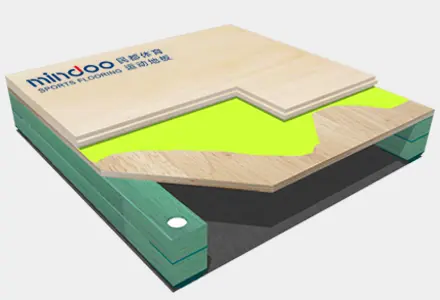Professional Sports Wood Flooring Comparison: Fixed vs. Portable Systems, Installation Structures, and Wood Species Expansion
The choice of sports wood flooring is determined not only by the wood species of the surface board but, critically, by the design and fixation method of the installation structure (Sub-structure). Fixed and portable systems represent two fundamentally different venue solutions, while the expansion of wood species offers varied performance characteristics and budget options.
I. Fixed Flooring: The Engineering of Batten Sub-Structures and Systems

Fixed flooring (also known as permanent or solid wood sports flooring) is a system installed directly onto the concrete base layer and is not easily dismantled. Its performance is entirely dependent on the resilient batten sub-structure beneath the surface board.
Basic Structure and Function: A fixed system typically includes, from bottom to top: a moisture barrier, elastic pads, the primary and secondary batten system, and the maple surface board. The batten system is the core component responsible for the floor’s resilience, shock absorption, and ventilation.
Types of Resilient Systems:
Single/Double Batten System: This is the most common structure, achieving structural suspension and shock absorption by placing high-elasticity rubber pads (or shock pads/resilient pads) beneath the battens. A double batten system typically offers a higher shock reduction rate and more uniform load distribution.
Panel System (Engineered Board System): This utilizes prefabricated engineered boards or plywood as the batten layer, laid over arrayed or honeycomb-patterned shock pads (e.g., Junckers' UnoBAT system). This structure offers advantages such as fast installation, low height profile, stable performance, and slightly lower requirements for concrete base flatness.
Ventilation and Moisture Control: Fixed flooring must maintain sufficient space between the battens and incorporate ventilation holes and skirting boards to create air circulation channels. This is vital for the floor's long-term stability, preventing moisture buildup and thus avoiding board deformation, warping, or decay.
II. Portable Flooring: The Key to Rapid Deployment and Multi-Functional Conversion

Portable flooring (also known as removable or modular flooring) is a professional, modular, and re-assembleable system, specifically designed for venues that require rapid venue conversion or hosting temporary high-profile events (such as major basketball tours or concerts).
Modular Design and Locking Mechanism: Portable floors consist of large, pre-assembled modules (typically 1m x 2m or larger). The core technology lies in the precision-engineered locking/connecting mechanisms. These locking devices (such as metal clips or slide-in tongue-and-groove systems) must ensure a flat surface plane and continuous athletic performance while allowing for rapid dismantling and re-installation.
Advantages and Applications:
Flexibility: Allows for the temporary setup of high-standard sports courts in multi-purpose arenas, large exhibition centers, or even outdoors.
Protection: During non-sporting events (like concerts or exhibitions), the floor can be dismantled and stored in designated areas, protecting the surface boards from unnecessary damage.
Challenges: Portable flooring systems must ensure that connection points do not create "hard spots" or discontinuities in play. This demands extremely high precision control over design and manufacturing tolerances. Professional storage pallets and environmental control are also necessary during non-use periods.
III. Expanding Sports Wood Species: Options Beyond Maple
Although Hard Maple is the unrivaled champion of the basketball world, other wood species are widely used globally in different sports and at various budget levels:
European Beech:
Characteristics: Beech is a traditional choice for European sports floors, boasting extremely high density and hardness, often called the "steel among woods" in Europe. It has a fine grain and is slightly redder in color than Maple.
Application: Widely used in handball, volleyball, and squash courts, as well as multi-purpose gymnasiums that emphasize hardness and abrasion resistance.
Process: Many European manufacturers use unique compression-drying processes on Beech, which can give it dimensional stability superior to even standard kiln-dried hardwoods.
Ash:
Characteristics: Ash has excellent toughness and shock resistance, an open, attractive grain, and performs excellently within resilient sub-structures. Its color is similar to Maple, and it has become increasingly popular in the Asian and European markets in recent years.
Application: Suitable for various general-purpose sports halls, especially venues requiring high shock absorption performance.
Oak and Birch:
Oak: Often found in lower-tier fitness or smaller venues. Its hardness is slightly lower than Maple and Beech, and its cost is generally lower, but its coarse texture is visually striking and decorative.
Birch: Due to its lower hardness and density compared to Maple, it is generally not used for top-tier professional competition courts. However, its price advantage and light appearance make it suitable for school gymnasiums or auxiliary training facilities.
Selecting sports wood flooring is a system engineering decision encompassing the surface board, elastic pads, and batten system. It must be comprehensively evaluated based on the venue's specific use, budget, and required international standards (such as EN 14904).
Fixed or Portable? Maple or Ash? Let mindoo Engineer Your Solution.
The right sub-structure defines the court. Whether your facility demands the robust, permanent engineering of a Fixed Batten System or the rapid, high-precision deployment of a Portable Modular Floor, mindoo Sports Flooring delivers.
As a leading manufacturer, we offer a complete material spectrum—from the top-tier Hard Maple and resilient European Beech to high-performance Ash—ensuring your floor system is perfectly aligned with your sport, budget, and EN standards.
Don't guess your installation structure. Trust the experts.
Contact mindoo today for a comprehensive consultation on system engineering and wood species selection. Visit our site now to learn how mindoo maximizes court performance and lifespan.